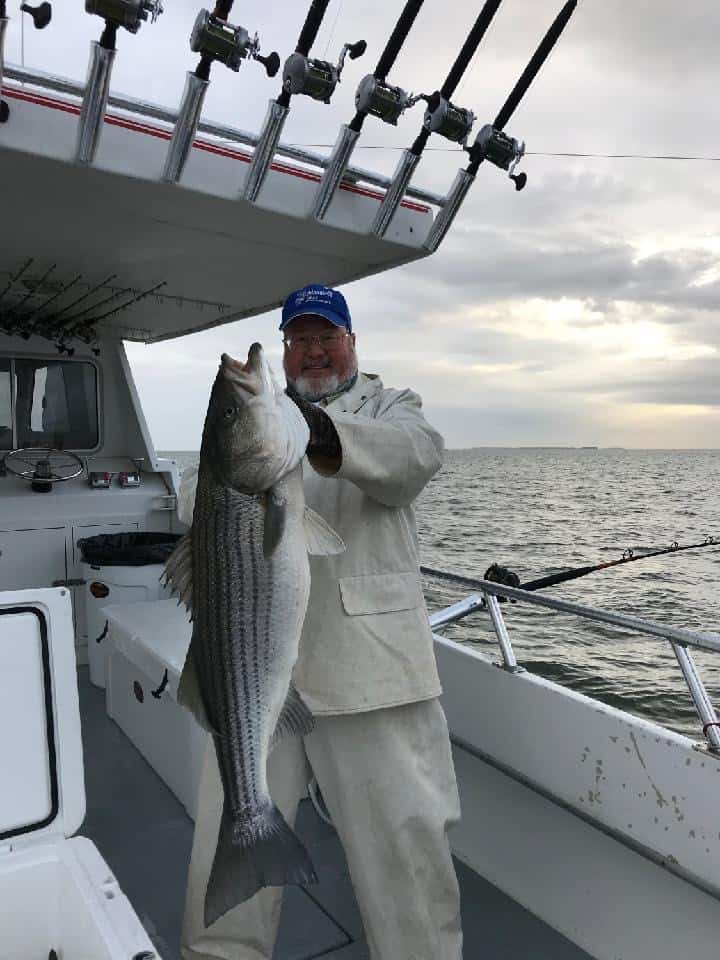Sporting Life

Early Season Rockfish Tactics
At last, the rockfish trophy season is upon us. Though the opener was quite lackluster, some anglers venturing forth did catch trophy-sized (35-inch) keepers. Trolling, of course, was the choice of most anglers, as it almost always is this part of the year.
Rockfish are now in spawning mode and are traveling in pods—the big fish migrating in from the Atlantic and the smaller, resident fish that currently reside in the Chesapeake full time. Male rockfish are mature and start to reproduce by two years old, females by four.
Females stripers won’t become fully productive, however, until the age of eight or so. A large migratory female can carry a half million eggs. Most rockfish leave the Bay after spawning for a totally migratory life in the Atlantic by eight years.
The season in the Chesapeake opened two weeks later this year; it is normally set by legislation to open the second weekend of April, but due to a precipitous drop in rockfish population numbers over the last five years, it was delayed to give the fish a longer period of respite in which to spawn.
The males arrive first in early springtime in the tributary headwaters (generally where they were born) and remain in those areas until gravid females stop arriving. The females will travel in their own exclusive groups and spawn a number of times when the conditions suit them.
Then the older, larger, migratory females will promptly exit the Bay to return to their life along the Atlantic Littoral and the smaller females along with the resident males will form up in larger schools for the coming summer. Rock fishing is legal only in the main stem of the Chesapeake until June 1, when the tributaries open to angling.
Almost all trophy-sized rockfish are constantly on the move this time of year, preparing to spawn, spawning or returning to the ocean. There are only three techniques that have a reasonable chance of success: trolling, chumming and bait fishing. Of the three, trolling produces the best odds for locating trophy-sized fish.
Traditional Bay trolling uses large baits, including big, 12-inch spoons, large bucktails with trailing soft plastic bodies (usually nine- to 12-inch Sassy Shads) along with multi-colored skirts and streamers. These baits mandate the use of heavy trolling tackle with 30- to 50-pound test line and even heavier leaders and sometimes up to 10 to 14 ounces of weight or more to get to the proper depth.
There is, though, an increasing tendency to use light tackle to troll. If you do, be sure you drag baits intended for your tackle. Large baits and large hooks are only effective with heavy duty trolling gear, only they can sink the large, stout, barbed hooks that go with these baits. A light tackle outfit cannot. Use lures and hooks designed for the tackle.
When chumming, keep in mind you will be targeting deeper-than-usual water, from 30 to 60 feet. Your chum might not be drifting down near the bottom where your baits rest unless you sink your chum bag. Rockfish on the feed are usually near the bottom.
Many chummers sink a bag down deep and another bag off the stern at the surface to also attract fish that are cruising there. It’s a good idea to also chunk (cut up and distribute pieces of fish) while you’re chumming or bait fishing. Stripers are school fish and they tend to feed together, so if one starts to eat, the behavior will spread, thus chunking can start up a bite.
This time of year is not the time to practice thrift when it comes to attracting, holding and encouraging rockfish. Be generous with your chum and baits.
Fishfinder:
A healthy number of Bay anglers were pleased with the bite during the opening week of trophy season but the general gist was that the better bite was to our south around Deale and east toward the Hill. There were not the usual quantity of boats on the water but the crowd wasn’t missed and motor noise wasn’t the fish chaser it sometimes can be this time of year. Trolling is the best producer and the traditional colors remain white, yellow and chartreuse. Best depth is the first 15 feet but watch your finder, if the fish go deep you must also. After you’ve got your one keeper, head for shallower water and look for some blue cats. They’re good eating, deserve the attention, love a piece of fresh menhaden, run up to 10 and 15 pounds and you can keep as many as you want.
Rockfish season is open, warm weather is upon us and all is right with the world. And remember the precept, “The lord does not subtract from our allotment of days those spent fishing, especially with a child.”
